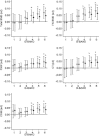Habitual levels of high, but not moderate or low, impact activity are positively related to hip BMD and geometry: results from a population-based study of adolescents
- PMID: 22492557
- PMCID: PMC3465797
- DOI: 10.1002/jbmr.1631
Habitual levels of high, but not moderate or low, impact activity are positively related to hip BMD and geometry: results from a population-based study of adolescents
Abstract
Whether a certain level of impact needs to be exceeded for physical activity (PA) to benefit bone accrual is currently unclear. To examine this question, we performed a cross-sectional analysis between PA and hip BMD in 724 adolescents (292 boys, mean 17.7 years) from the Avon Longitudinal Study of Parents and Children (ALSPAC), partitioning outputs from a Newtest accelerometer into six different impact bands. Counts within 2.1 to 3.1g, 3.1 to 4.2g, 4.2 to 5.1g, and >5.1g bands were positively related to femoral neck (FN) BMD, in boys and girls combined, in our minimally adjusted model including age, height, and sex (0.5-1.1g: beta = -0.007, p = 0.8; 1.1-2.1g: beta = 0.003, p = 0.9; 2.1-3.1g: beta = 0.042, p = 0.08; 3.1-4.2g: beta = 0.058, p = 0.009; 4.2-5.1g: beta = 0.070, p = 0.001; >5.1g: beta = 0.080, p < 0.001) (beta = SD change per doubling in activity). Similar positive relationships were observed between high-impact bands and BMD at other hip sites (ward's triangle, total hip), hip structure indices derived by hip structural analysis of dual-energy X-ray absorptiometry (DXA) scans (FN width, cross-sectional area, cortical thickness), and predicted strength (cross-sectional moment of inertia). In analyses where adjacent bands were combined and then adjusted for other impacts, high impacts (>4.2g) were positively related to FN BMD, whereas, if anything, moderate (2.1-4.2g) and low impacts (0.5-2.1g) were inversely related (low: beta = -0.052, p = 0.2; medium: beta = -0.058, p = 0.2; high: beta = 0.137, p < 0.001). Though slightly attenuated, the positive association between PA and FN BMD, confined to high impacts, was still observed after adjustment for fat mass, lean mass, and socioeconomic position (high: beta = 0.096, p = 0.016). These results suggest that PA associated with impacts >4.2g, such as jumping and running (which further studies suggested requires speeds >10 km/h) is positively related to hip BMD and structure in adolescents, whereas moderate impact activity (eg, jogging) is of little benefit. Hence, PA may only strengthen lower limb bones in adolescents, and possibly adults, if this comprises high-impact activity.
Copyright © 2012 American Society for Bone and Mineral Research.
Figures

Comment in
-
Bone: impact loading-nature's way to strengthen bone.Nat Rev Endocrinol. 2012 May 29;8(7):391-3. doi: 10.1038/nrendo.2012.88. Nat Rev Endocrinol. 2012. PMID: 22640997 No abstract available.
Similar articles
-
Habitual levels of higher, but not medium or low, impact physical activity are positively related to lower limb bone strength in older women: findings from a population-based study using accelerometers to classify impact magnitude.Osteoporos Int. 2017 Oct;28(10):2813-2822. doi: 10.1007/s00198-016-3863-5. Epub 2016 Dec 13. Osteoporos Int. 2017. PMID: 27966105 Free PMC article.
-
Lean mass and lower limb muscle function in relation to hip strength, geometry and fracture risk indices in community-dwelling older women.Osteoporos Int. 2019 Jan;30(1):211-220. doi: 10.1007/s00198-018-4795-z. Epub 2018 Dec 14. Osteoporos Int. 2019. PMID: 30552442 Free PMC article.
-
Changes in femoral neck bone mineral density and structural strength during a 12-month multicomponent exercise intervention among older adults - Does accelerometer-measured physical activity matter?Bone. 2024 Jan;178:116951. doi: 10.1016/j.bone.2023.116951. Epub 2023 Oct 31. Bone. 2024. PMID: 37913888
-
Sex specific association of physical activity on proximal femur BMD in 9 to 10 year-old children.PLoS One. 2012;7(11):e50657. doi: 10.1371/journal.pone.0050657. Epub 2012 Nov 29. PLoS One. 2012. PMID: 23209801 Free PMC article.
-
Physical Activity and Bone: May the Force be with You.Front Endocrinol (Lausanne). 2014 Mar 3;5:20. doi: 10.3389/fendo.2014.00020. eCollection 2014. Front Endocrinol (Lausanne). 2014. PMID: 24624117 Free PMC article. Review.
Cited by
-
Influence of Habitual Physical Behavior - Sleeping, Sedentarism, Physical Activity - On Bone Health in Community-Dwelling Older People.Front Physiol. 2019 Apr 15;10:408. doi: 10.3389/fphys.2019.00408. eCollection 2019. Front Physiol. 2019. PMID: 31037056 Free PMC article.
-
Children with myelomeningocele do not exhibit normal remodeling of tibia roundness with physical development.Bone. 2018 Sep;114:292-297. doi: 10.1016/j.bone.2018.07.001. Epub 2018 Jul 4. Bone. 2018. PMID: 29991457 Free PMC article.
-
A novel accelerometer-based method to describe day-to-day exposure to potentially osteogenic vertical impacts in older adults: findings from a multi-cohort study.Osteoporos Int. 2017 Mar;28(3):1001-1011. doi: 10.1007/s00198-016-3810-5. Epub 2016 Oct 31. Osteoporos Int. 2017. PMID: 27798733 Free PMC article.
-
Transient peak-strain matching partially recovers the age-impaired mechanoadaptive cortical bone response.Sci Rep. 2018 Apr 27;8(1):6636. doi: 10.1038/s41598-018-25084-6. Sci Rep. 2018. PMID: 29703931 Free PMC article.
-
Can physical activity improve peak bone mass?Curr Osteoporos Rep. 2013 Sep;11(3):229-36. doi: 10.1007/s11914-013-0152-5. Curr Osteoporos Rep. 2013. PMID: 23832810 Review.
References
-
- Goodship AE, Lanyon LE, McFie H. Functional adaptation of bone in increased stress. J Bone Joint Surg. 1979;61A:539–46. - PubMed
-
- Rubin CT, Lanyon LE. Regulation of bone mass by mechanical strain magnitude. Calcif Tissue Int. 1985;37:411–7. - PubMed
-
- Duda GN, Kirchner H, Wilke HJ, Claes L. A method to determine the 3-D stiffness of fracture fixation devices and its application to predict inter-fragmentary movement. J Biomech. 1998;31(3):247–52. - PubMed
-
- Rittweger J, Beller G, Ehrig J, Jung C, Koch U, Ramolla J, Schmidt F, Newitt D, Majumdar S, Schiessl H, Felsenberg D. Bone-muscle strength indices for the human lower leg. Bone. 2000;27(2):319–26. - PubMed
-
- Hind K, Burrows M. Weight-bearing exercise and bone mineral accrual in children and adolescents: a review of controlled trials. Bone. 2007;40(1):14–27. - PubMed
Publication types
MeSH terms
Grants and funding
LinkOut - more resources
Full Text Sources
Medical
Miscellaneous

